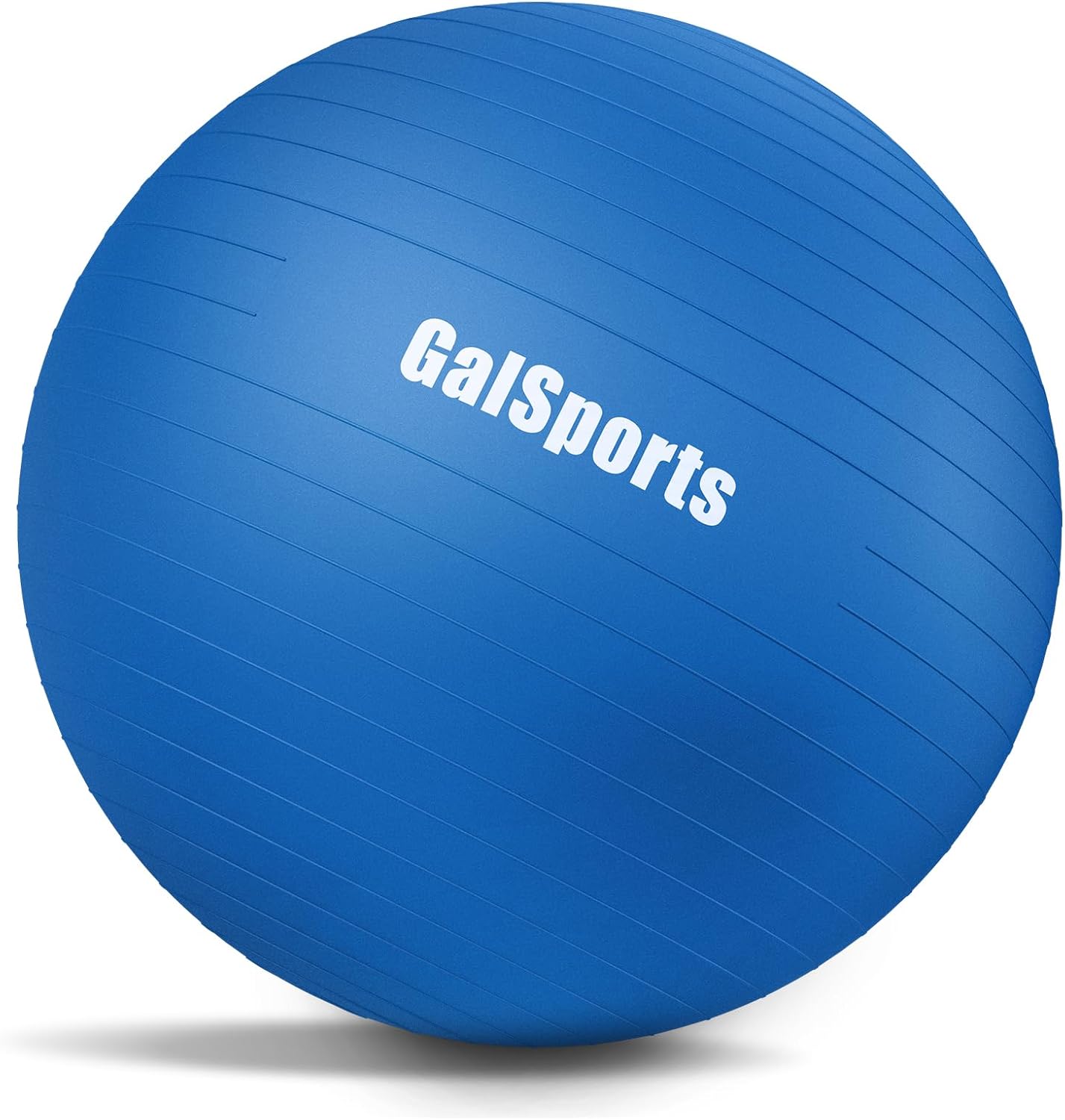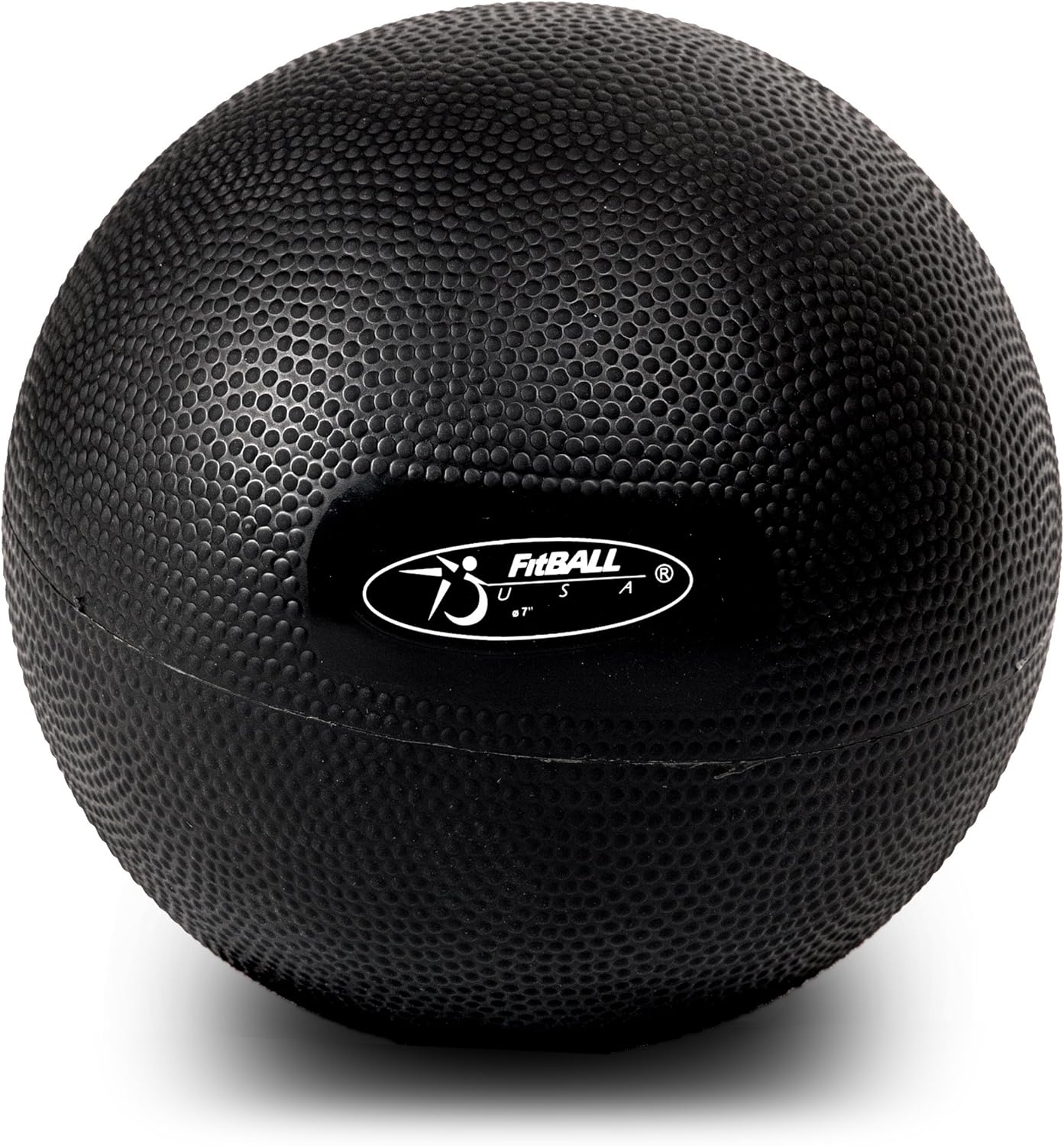Yoga Ball, also known as a fitness ball or Swiss ball, is a fantastic fusion of traditional yoga poses and the use of a fitness ball. As a Yoga Ball practitioner, I find that it adds an extra layer of fun and challenge to my yoga routine.
The primary goal of using a Yoga Ball is to enhance focus, alleviate mental stress, burn fat, and strengthen the endurance of my limbs and spine. It also significantly improves my body coordination.
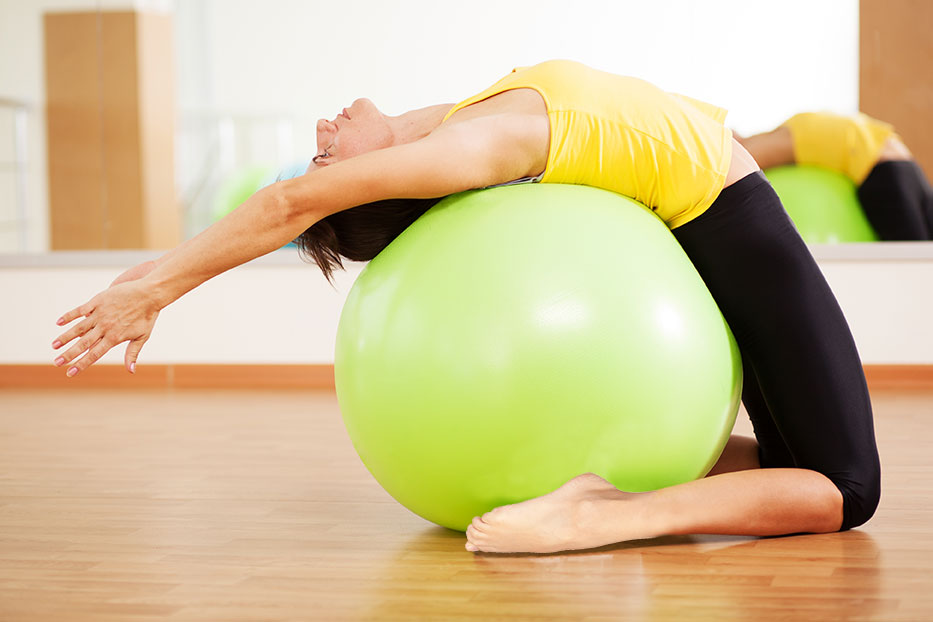
The Yoga Ball is typically made of PVC, a harmless material known for its explosion-proof and thickened qualities, ensuring both safety and durability during practice.
Choosing the right size of the Yoga Ball is crucial, and it depends on my height. For instance, if I’m around 1.5-1.6 meters tall, a ball with a diameter of 55-60 centimeters would be ideal for me.
The exercises with the Yoga Ball primarily target my abdomen, back, waist, and legs. By performing stretches and squeezes in conjunction with slow breathing, I can effectively massage and relax my muscles while burning fat.
Regular practice with the Yoga Ball not only helps me maintain a fit physique but also enhances my body’s flexibility and balance. It boosts my cardiovascular function, promotes blood circulation, and corrects poor posture like rounded shoulders and a hunched back.
Before starting my Yoga Ball session, I ensure that the ball is fully inflated and remove any accessories that might puncture it. During practice, I focus on controlling the ball’s bounce, stabilizing my core, and synchronizing my movements with my breath.
It’s important to remember that Yoga Ball practice should be tailored to my individual limits and not be compared to others. I progress gradually, listening to my body’s signals.
To practice safely, I prefer to do Yoga Ball exercises on an empty stomach or at least two hours after eating. If I experience any discomfort, such as difficulty breathing or headaches, I immediately stop.
Yoga Ball is suitable for everyone, including those undergoing rehabilitation. Its fitness benefits are remarkable, especially for the spine and pelvis. Moreover, exercising with a Yoga Ball is relatively safe and less prone to injuries.
With various brands and sizes available in the market, I can choose a Yoga Ball that suits my preferences and budget. Overall, Yoga Ball is an excellent addition to my fitness routine, offering a wide range of benefits and a versatile workout experience.
Types of Yoga Balls
1.Standard Stability Ball: This is the most common type, used for improving core strength, balance, and flexibility.
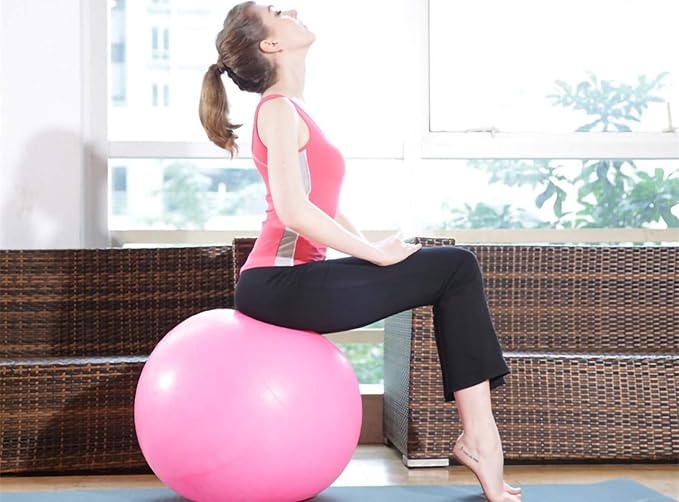
2.Mini Exercise Ball: Also known as a “Pilates ball,” it’s smaller and often used for more targeted exercises and to enhance stability during workouts.
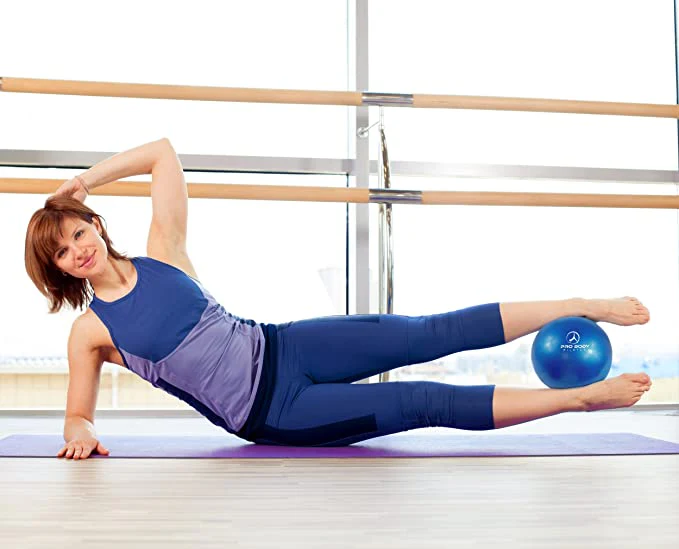
3.Therapy Ball: These are often used for physical therapy and rehabilitation. They come in various sizes and can be softer or firmer depending on the need.

4.Weighted Ball: This type has added weight inside, providing extra resistance and making workouts more challenging.
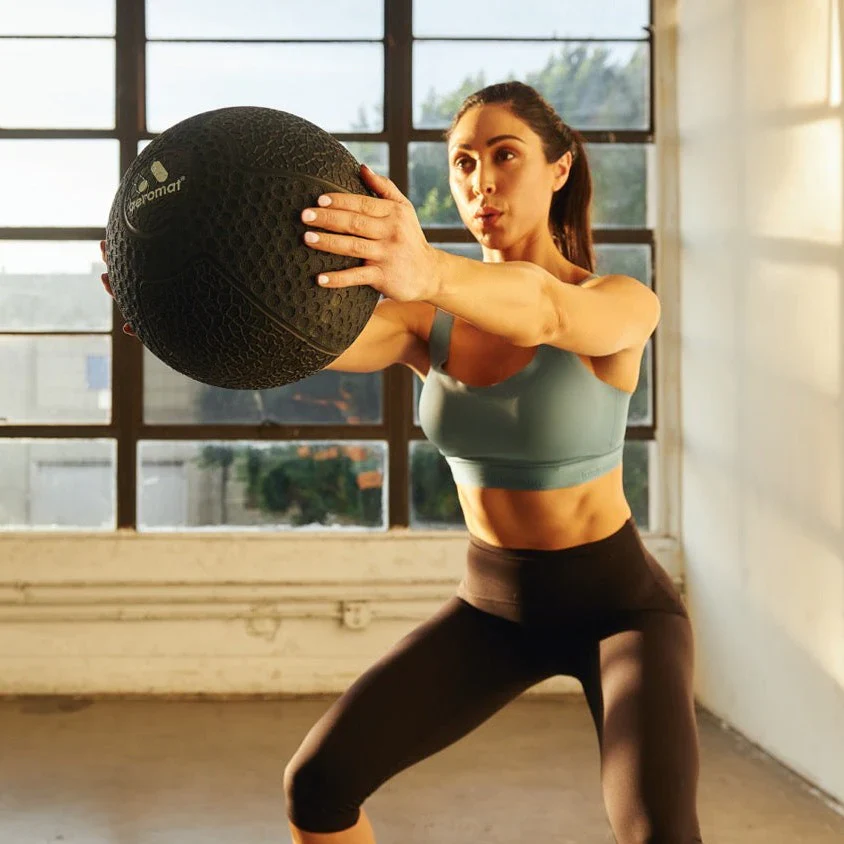
5.Bosu Ball: Although not a traditional yoga ball, the Bosu ball is half stability ball and half flat surface. It’s used for balancing exercises and stability training.

How To Use A Yoga Ball?
1.Crunches
Let’s start with the basics. Lie face up on the ball, resting it on your lower back. Stand with your feet on the ground, hip-width apart, and your hands behind your ears.
Keep your core tight, tighten your glutes, and slowly contract your upper body upward, lifting your shoulders off the ball and bringing your chin to your chest. Slowly lower your upper body back to the start.
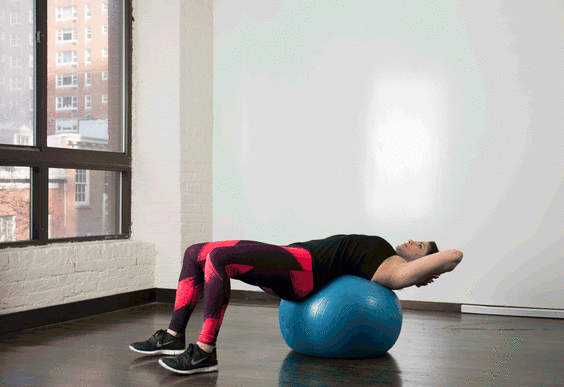
2.Oblique Crunches
Start in the same position as above. Brace your core, tighten your glutes, and slowly contract to the right. Lift your shoulder blades off the ball and rotate your upper body to the right. Lower your back and repeat on the left side.

3.Knee Raises
Balancing on the ball, keeping your core tight, lift your right foot off the ground and bring your right knee toward your chest. Slowly switch feet, then repeat on the other side.
You can do this exercise next to a wall or pillar to help you balance.

4.Plank
This is a balance exercise. Start in a high plank with your wrists under your shoulders and your toes on the ball. Keep your hips level and use your core to pull your knees toward your chest and roll the ball toward you. Straighten your legs and return to the starting point.
You can also choose a static position and hold the high plank at the beginning with your feet on the ball for 30 to 60 seconds.
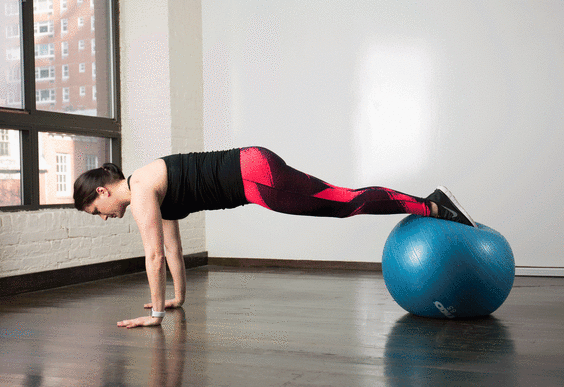
5.Forearm Plank
Start in a forearm plank with your forearms on the ball, legs extended, core braced, hips level. Feet should be close together. Keep your core tight and feet wide open. Now quickly jump them back together, returning to start.

6.Hand-to-foot pass
Lie faceup with legs extended and arms raised overhead, holding the ball in both hands. Do sit-ups, engaging your core while lifting your shoulders, arms, and straightened legs.
Lift your arms and legs and pass the ball from your hands to your feet, squeezing your thighs and feet to hold the ball in place. Lower your hands, feet, and torso. Repeat, this time passing the ball back to your hands.
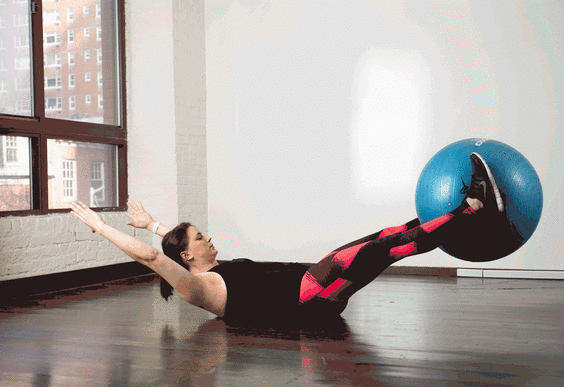
Ball yoga can reduce the difficulty, especially pregnancy yoga, postpartum yoga and some restorative yoga, but ball yoga can also exercise the core, reduce fat and increase muscle. You must know that the yoga ball is unstable. If you want the ball to be stable, you have to activate more muscles.
Action 1
Place the yoga ball at one end of the yoga mat, lie prone with your feet on both sides of the yoga ball; support yourself with your hands and enter the plank pose, tighten your core; place your feet on the yoga ball one by one; always keep your core tight and do not collapse your waist, and stay for 30-60 seconds.

Action 2
Press your abdomen on the yoga ball, with your feet on the ground and your legs straight; tighten your core, and as you exhale, lift your right foot up without moving your pelvis; do it 15-20 times on one side, and do the same number of times on the other side.
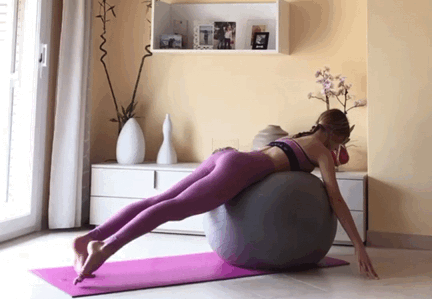
Action 3
On the basis of action 2, support the ground with both hands and bend your legs at the same time; keep your thighs level with the ground, exert your hips and lift your feet up; tighten your core and do 10-20 sets of dynamic movements.
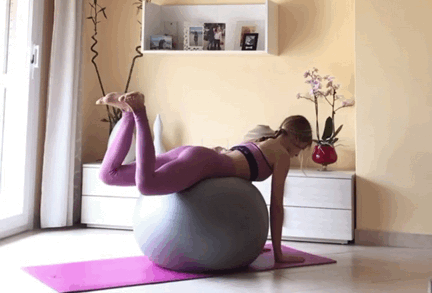
Action 4
Press the ball under the right armpit, side plank, bend the right knee; when exhaling, use the hips to lift the left leg up; the movement does not need to be too fast, tighten the core, repeat 15-20 times; switch to the other side to practice.

Action 5
Lean your upper back against the yoga ball, bend your legs and sit with your feet slightly wider than your pelvis; hold your hips with both hands and tighten your core; inhale to stretch your chest and exhale to lift your hips upward; one inhalation and one exhalation is one set, repeat 8-10 sets.

Action 6
On the basis of action 5, keep your core tight and your collarbones open; when you exhale, tighten your gluteal muscles and lift your heels. Inhale and land; repeat the exercise 10-20 times.

Action 7
Place the yoga ball at one end of the mat, bend your knees and lie on your back; straighten your legs, put your feet on the yoga ball, and press your arms to the ground at your sides; exhale and lift your hips, slightly curl your tailbone and lumbar spine without squeezing; inhale to land, exhale to lift, repeat 10-15 sets.
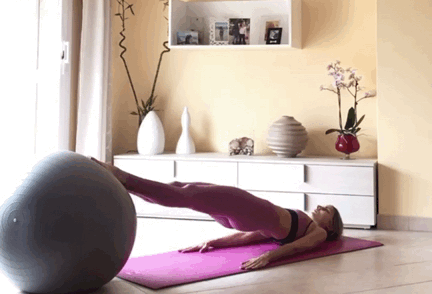
Action 8
On the basis of action 7, bend your legs and open your knees slightly outward; when you exhale, tighten your core, gluteal muscles, and lift your pelvis upward; the movement should not be too fast, and repeat 10-20 times.

Action 9
Press your back and waist on the yoga ball, with your hips suspended in the air, your knees bent, and your feet on the ground; put your hands behind your ears, tighten your core, and do crunches as you exhale; inhale to return to the starting position, and repeat the exercise 15-20 times.
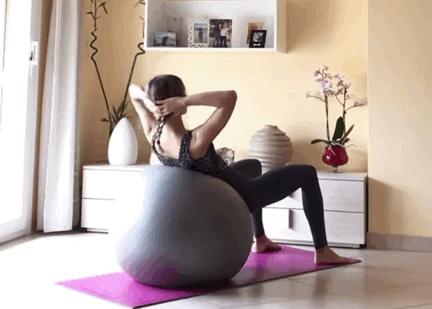
Action 10
Sit with your knees bent, feet together, and hold the yoga ball with both hands; tighten your core, lean back slightly, and exhale. Exhale, tighten your core, hold the ball with your hands, and twist your body to the right; inhale and turn forward, exhale and turn to the left; alternate left and right, and repeat 8-10 times.

Action 11
Lie on your back, hold a yoga ball between your feet, and clench your hands with your fingers crossed after you throw your body. Lift the yoga ball between your feet, keep your calves parallel to the ground, and tighten your core. As you exhale, lift your chest upwards, and as you inhale, lower your chest to the ground. Repeat 10-20 times.

Action 12
Lie on your back, hold the yoga ball vertically with your hands and legs; when you exhale, slowly lower your left hand and right leg but do not touch the ground, inhale and bring them back; exhale again and alternate sides, with your right hand and left leg touching the ground; alternating left and right is one set, and practice alternating for 15-20 sets.
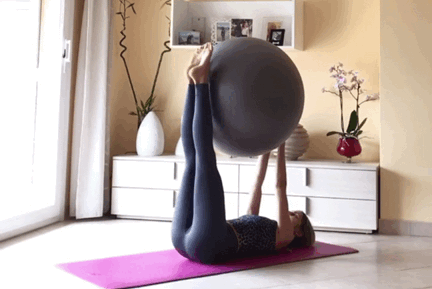
Action 13
Lie on your back with your legs bent, feet on the ball, and hands straightened and raised above your head; as you exhale, move your feet forward to move the yoga ball, do a crunch with your head touching your knees; inhale to return to the original position, and repeat 10-15 times.

Action 14
Lie on your back with your legs bent, your calves parallel to the ground, and a yoga ball on your calves; keep the yoga ball in place, tighten your core, lift your head, and chest; as you exhale, clap your hands rhythmically 15-20 times; repeat 5-8 breaths.

Precautions:
- Ensure a safe environment when using the yoga ball, avoiding slippery or uneven surfaces.
- Beginners should start with low-intensity exercises and gradually increase the difficulty and intensity.
- Maintain smooth breathing and avoid holding your breath.
- If you experience any discomfort or pain, stop immediately and seek professional guidance.
What size yoga ball should I buy?
The size of the yoga ball you should buy depends on your height and personal preference. Here are some general guidelines:
- If you are 5’2″ or shorter, a 55cm yoga ball is typically recommended.
- If you are between 5’3″ and 5’8″, a 65cm yoga ball is usually suitable.
- If you are 5’9″ or taller, a 75cm yoga ball may be more comfortable.

What Brand Of Yoga Ball Is Good?
1.TheraBand: Known for its high-quality fitness products, TheraBand offers durable and burst-resistant yoga balls suitable for both home and professional use.
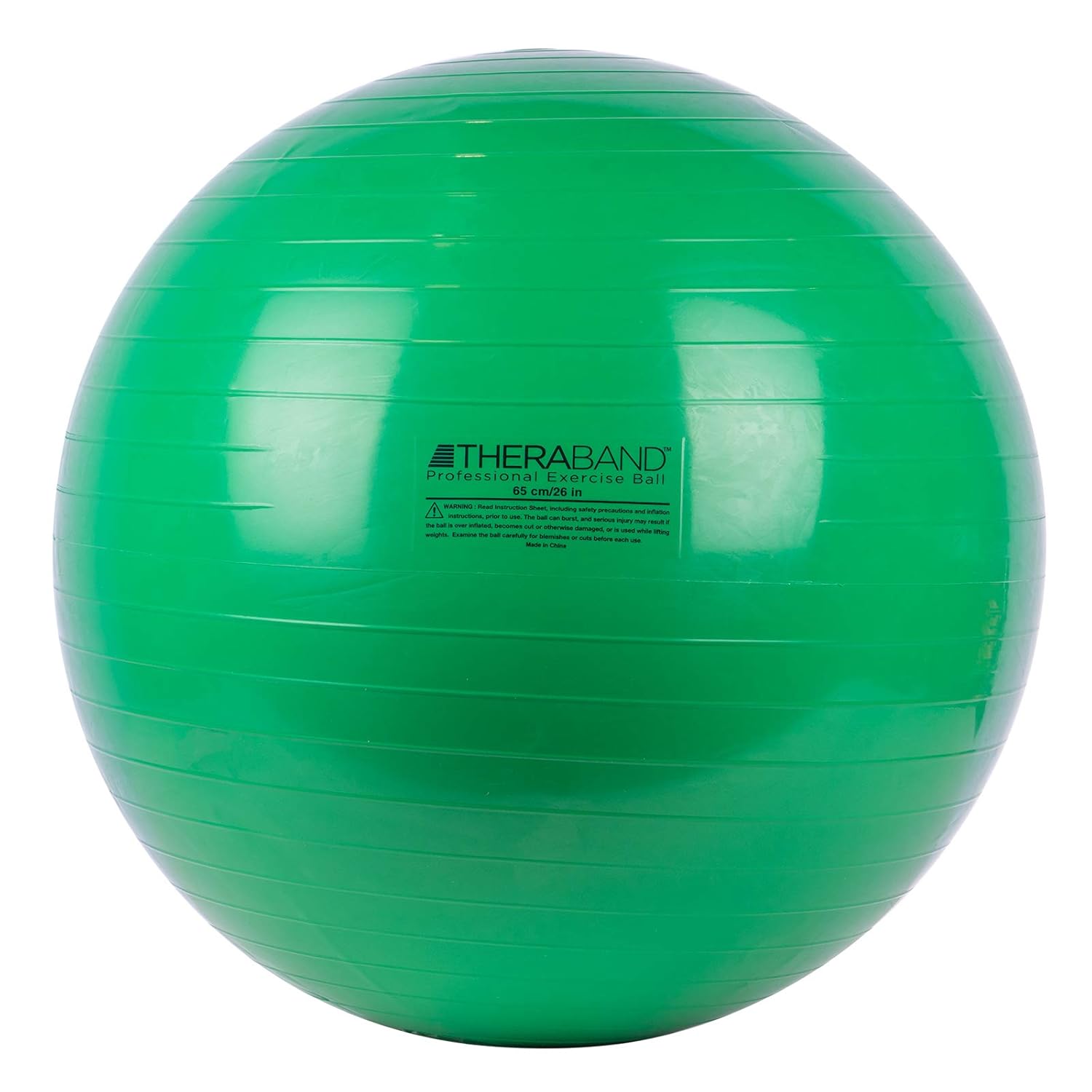
THERABAND Exercise Ball, Stability Ball with 65 cm Diameter for Athletes 5’7″ to 6’1″ Tall
2.Trideer: Trideer is well-regarded for its thick and anti-burst yoga balls, often used for exercises, physical therapy, and as ergonomic office chairs.

Trideer Yoga Ball Exercise Ball for Working Out, 5 Sizes Gym Ball, Birthing Ball for Pregnancy
3.URBNFit: URBNFit offers versatile yoga balls that come with hand pumps and workout guides. They are popular for their durability and grip.
4.Live Infinitely: This brand is known for its heavy-duty and anti-burst yoga balls, often used in fitness, therapy, and pregnancy exercises.

Live Infinitely Exercise Ball (55cm-95cm) Extra Thick Professional Grade Balance & Stability Ball
5.Gaiam: Gaiam is a trusted name in the fitness industry, offering yoga balls that are often accompanied by exercise guides and videos. They are known for their stylish designs and functionality.
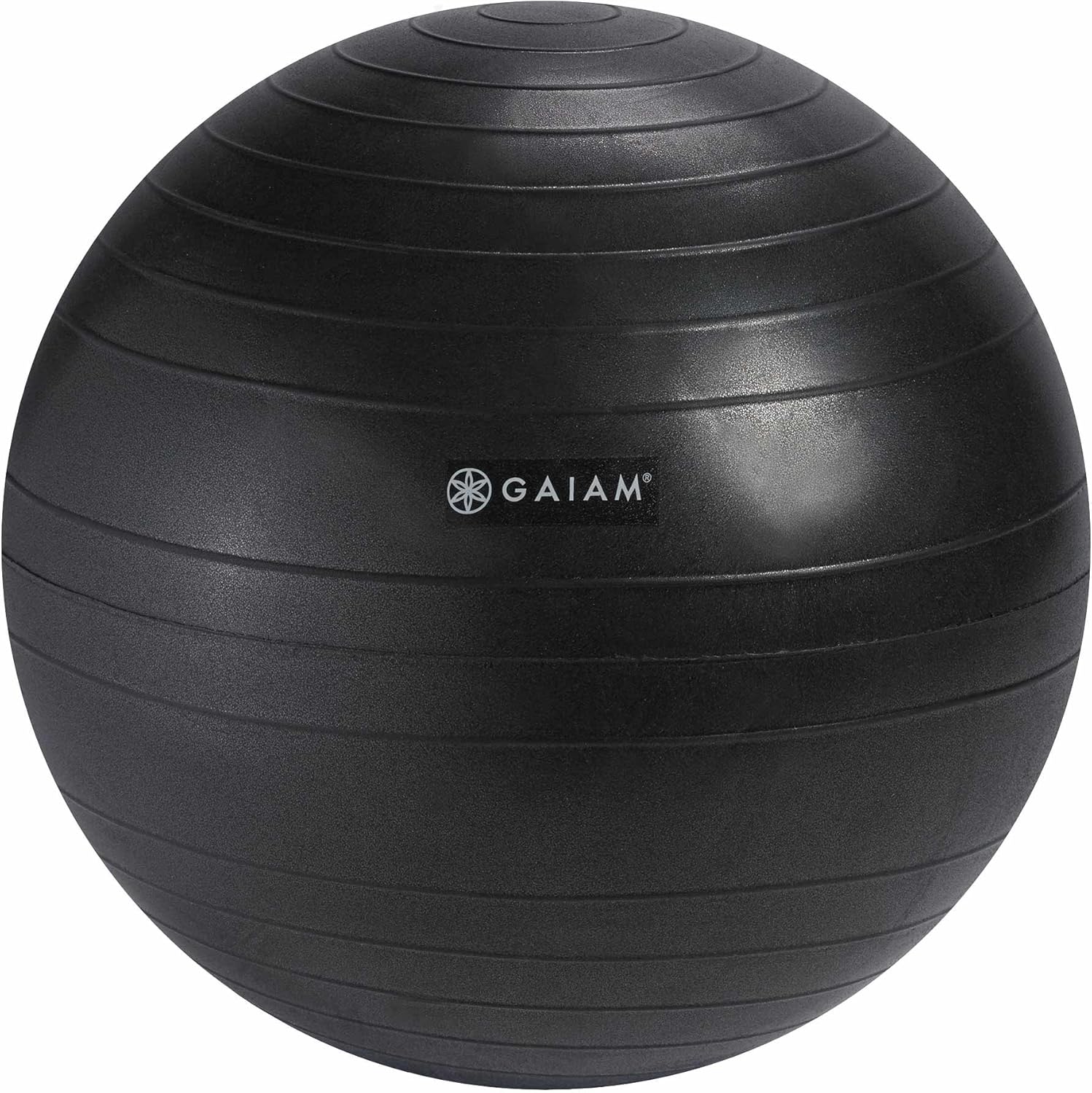
Gaiam Classic Balance Ball Chair Ball – Extra 52cm Balance Ball for Classic Balance Ball Chairs
6.FitBALL: FitBALL provides a range of professional-grade exercise balls that are burst-resistant and come in various sizes. They are widely used in physical therapy and fitness training.
7.Dynapro: Dynapro offers commercial-grade anti-burst yoga balls, known for their thickness and durability, suitable for intense workouts and daily use.
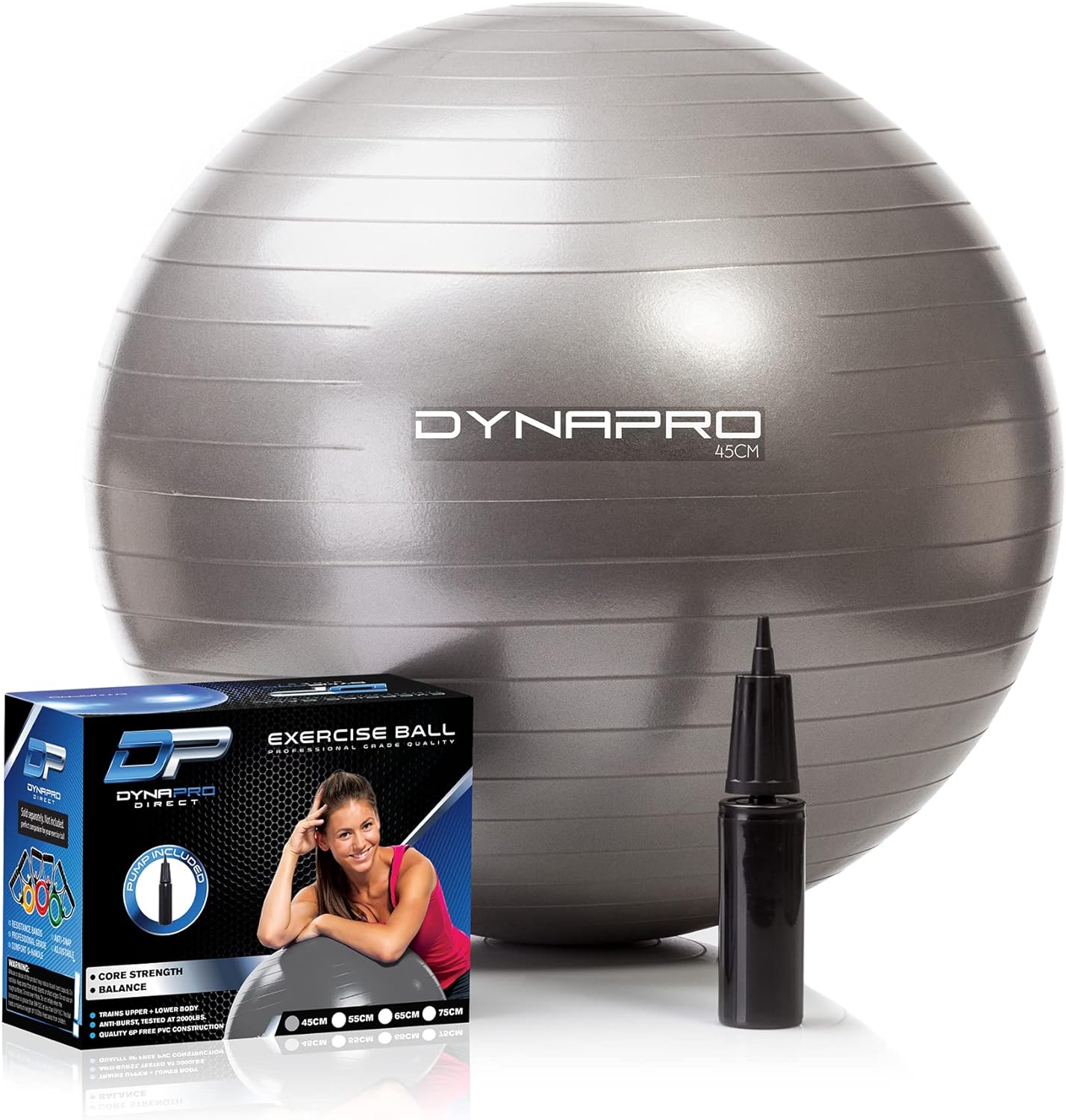
Exercise Ball – Extra Thick Eco-Friendly & Anti-Burst Material Supports over 2200lbs, Stability Ball for Home, Yoga
8.GalSports: GalSports yoga balls are known for their high weight capacity and anti-slip surface, making them suitable for a variety of fitness and balance exercises.
